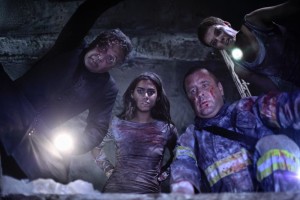 Aftershock (Nicolás López, USA/Chile, 2012, 89 min)
Aftershock (Nicolás López, USA/Chile, 2012, 89 min)
UW Cinematheque, Sat Feb 8, 9:00pm»
Aftershock, directed by Nicolas Lopez and written by Lopez and Eli Roth, follows a group of tourists in Chile whose partying is rudely interrupted by an devastating earthquake. The film is like many other horror films where tourists in an exotic city, hoping to get wild, end up stuck in a horrifying situation. Its corniness and ridiculous nature makes it hard to take the film seriously. However, its extreme shift in tone at the start of the earthquake, and the violent and blood-drenched encounters that follow, produces an entertaining film that is extremely funny at times. Since we never form sympathy for the characters, watching them die is very comical. And they die in graphically vulgar ways.
The first scene opens in a club where the American tourist, Gringo (Eli Roth), is exposed to Chile’s party scene by Ariel and Pollo. There’s loud music, constant strobe lights and a concentration on women’s mid-sections. One moment Gringo is squatting next to a woman, ogling her shaking butt and the next moment he is passed out on the floor. The dynamic of the group is set-up quickly: Ariel is the sensitive, recently heart-broken one; Pollo is the rich, well-connected player; and Gringo is the naive American tourist who can’t hold his liquor.
The film relies on many stereotypes—young women are always shown as beautiful, party-crazed and easily impressed. It only takes Pollo waving around a little money to convince a gorgeous group of girls—Kylie, Monica and Irene—to come along to Valparaiso. In the city, a montage sequence shows the group at various locations laughing and having a great time, slapping each others butts and eating ice cream cones. It ends with a visit to a graveyard. One specific tombstone is singled out as Ariel points to a church and informs us that this is where the priests and nuns bury their children after having sex in the tunnels. This information seems odd and irrelevant at the time. Monica is uneasy.
Monica is a buzzkill; her half-sister Kylie loves to get wild; and Irene is the model with brains whom Gringo desperately wants to seduce. Unfortunately Irene becomes quickly swept away by the slimy Russell Dazzle when he enters a party with an elaborate dance sequence—again showing that women are easily impressed. From the first half of the film it is clear that all of the characters have silly problems; good thing an earthquake is coming.
During a fight between the sisters, where we find out that Monica had an abortion and that Kylie has slept with Pollo, the club starts shaking. Within seconds the place is in total chaos and people are running around screaming, getting crushed by falling objects and their blood is spraying everywhere. Ariel’s hand gets sliced off and Kylie starts puking when she sees his bloody stump. Luckily, Monica spots the hand and slides it into her purse as if it were a wallet. The earthquake puts into perspective the ridiculousness of their petty problems.
When they emerge from the underground club, they find that the entire city is in ruins. Aftershocks are not the only new threat: the prison was destroyed and the inmates have escaped. Another stereotype helps here: you can tell if someone is a prisoner by their tattoos. Regardless of the nice things that they may have done previously, the girls assume that anyone with tattoos will probably try to rape them.
The group is chased by the prisoners to the church where the priests and nuns have sex. I am glad they came back to the church because the exposition given at the graveyard seemed a waste of 10 minutes of screen time. Within the church, the film seems to draw comparisons between dead fetuses buried by the nuns and priests and Monica’s abortion. It may be there merely for shock value, much like other scenes in the film. But more likely the filmmakers are suggesting that Monica is being punished for having an abortion—perhaps like the others have been punished by living hedonically. However, the connection between Monica’s abortion and the buried fetuses, two things that are extraneous to the main plot line, is never developed enough to produce a clear message and therefore the meaning is lost.
The story is fairly predictable, and extremely corny. And then there’s the uncomfortable cameo by Selena Gomez. The film attempts to do a lot but nothing is developed enough to become particularly meaningful. Another example of this is an odd trend that’s incorporated in the first half of the film where title cards inform us of the day of the week—Tuesday they are at a club, Wednesday at a vineyard, Thursday they meet the women and Friday the earthquake—yet it is never clear the importance of the title cards or why the day of the week matters.
Yet, if you take the film at face value, which is silly and senseless, it ends up being fairly amusing. The gore, though a bit cheesy, is graphic and the content is crude and these things are what make the film—at least the second half—enjoyable to watch. It’s really fun watching these unsympathetic characters die, especially in such unexpected and gory ways.
If you happen to miss the one Cinematheque screening on Saturday night and still want to catch the film, it is currently streaming on Netflix Watch Instantly.